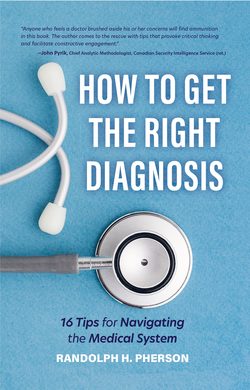Читать книгу How to Get the Right Diagnosis - Randolph H. Pherson - Страница 9
На сайте Литреса книга снята с продажи.
ОглавлениеForeword by John Gannon
Randy Pherson and I were fellow analysts and friends over long careers at the CIA. We worked together closely in the final years of our careers on the National Intelligence Council where I served as chairman for four years. Randy was an outstanding National Intelligence Officer (NIO) for Latin America during a turbulent time in the region. He was widely respected for his energetic advancement of analytic tradecraft in the information age and for his aggressive outreach to outside sources of expertise in the early post-Cold War period—passions that he brought to improving the quality of analytic tradecraft after retiring from the CIA.
In his thought-provoking book, How to Get the Right Diagnosis, Randy notes that intelligence analysts and medical personnel face similar challenges in collecting reliable data to reduce uncertainty and sharpen diagnoses. He reveals how the methodologies and practices he employed so successfully in the US Intelligence Community can also help fill data gaps and contribute to a more complete and accurate medical diagnosis. In this book, he methodically lays out practical prescriptions for prevention, response, and recovery.
Both of us were avid runners who prided ourselves on staying in shape to meet the demands of our often-stressful work. Yet we both surprised ourselves and shocked our families and friends by having life-threatening medical conditions. Randy’s story, typical of an intensely curious analyst with a healthy bent toward skepticism, is about his forceful challenge to medical experts. The experts believed they had a better grasp of available data on his evolving diagnosis than he did—and turned out to be wrong.
My story parallels Randy’s in many ways. It begins with my own failure to question flawed assumptions about the correlation between apparent good health and immunity from heart disease. I was an in-shape nonsmoker, a sensible eater with no significant family history of diabetes or heart disease. With eight marathons under my belt, I continued to jog regularly, swim every day, and play tennis twice a week. I thought I was in top condition until I almost died from a heart attack after a stressful day in the rugged hills of western Croatia. Unlike Randy who took charge of his medical care, I blame myself for not working with a primary care physician to monitor a growing blood pressure problem related to cholesterol. The alarming data would have been discovered had I sought it—what we sometimes refer to as an “unknown known.”
The author’s recommendations flow from the basic admonition to take charge, be a proactive participant in your diagnosis and treatment, listen attentively to your own body, ask your doctors every hard question that comes to mind, express doubts when you have them, take notes to help organize and prioritize your issues and concerns, collect your own data to fill inevitable gaps, and keep a data-rich account of your medical history. Above all, never settle on being a passive consumer of your medical data or a silent observer of medical systems and practices. You should interact constantly and vigorously with your doctors and other medical personnel.
In closing, I would like to offer two personal observations related to emotions that go beyond the usual medical discussion of innovative medical procedures and pathbreaking drug therapies. Lots of empirical evidence speaks to the wider relevance of my issues to health. The first is the role of stress in elevating the chances of a heart attack and slowing recovery. This is not that complicated. I know from personal experience that we simply can and should learn to reduce the stress in our lives as an investment in good health. Second is the impact of human relationships. From the moment I arrived at a Croatian ICU, I believed I could and would get better. I was kept grounded with high morale by the constant reassuring presence of my wife, Mary Ellen, and by the loving support of our children, grandchildren, and close friends. These folks were a powerful driver in my survival and recovery. I’m not sending a Hallmark card here. I’m providing hard data you can take to the bank. Investment in people pays rich dividends!
The good news for Randy and me is that the excellent medical procedures and continuing care we received in the same Northern Virginia hospital, our healthy diets, our regular physical exercise, and our robust network of close family and friends have boosted our resilience and speeded our recovery, turning a brush with death into a wake-up call—a second chance for a long, active life with the people we love. We are still here to tell our stories. We are lucky guys, and we know it!
Randy Pherson made himself a proactive participant in the diagnosis and treatment of his condition and, ultimately, in saving his own life. This gripping story and the sound advice he offers are certain to help others take charge of their health care. We all should take his good advice to heart!
John Gannon
Former Chairman, US National Intelligence Council
Falls Church, Virginia
January 8, 2019
